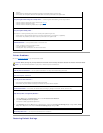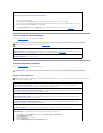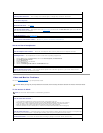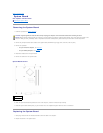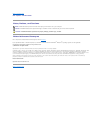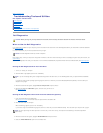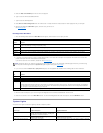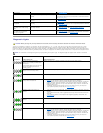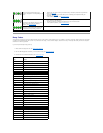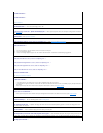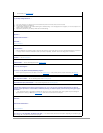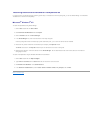
Beep Codes
Your computer might emit a series of beeps during start-up if the monitor cannot display errors or problems. This series of beeps, called a beep code, identifies
a problem. One possible beep code (code 1-3-1) consists of one beep, a burst of three beeps, and then one beep. This beep code tells you that the computer
encountered a memory problem.
If your computer beeps during start-up:
1. Write down the beep code on the Diagnostics Checklist.
2. Run the Dell Diagnostics to identify a more serious cause (see Dell Diagnostics).
3. Contact Dell for technical assistance (see Contacting Dell).
Memory modules are detected, but a
memory configuration or compatibility error
exists.
l Ensure that no special memory module/memory connector placement requirements
exist (see Memory).
l Verify that the memory modules that you are installing are compatible with your
computer (see Memory).
l If the problem persists, (see Contacting Dell).
A failure has occurred.
This pattern also displays when you enter
system setup and may not indicate a
problem (see System Setup).
l Ensure that the cables are properly connected to the system board from the hard
drive, CD drive, and DVD drive.
l Check the computer message that appears on your monitor screen.
l If the problem persists, (see Contacting Dell).
After POST is complete, all four diagnostic
lights turn green briefly before turning off
to indicate normal operating condition.
None.
Code
Cause
1-1-2
Microprocessor register failure
1-1-3
NVRAM read/write failure
1-1-4
ROM BIOS checksum failure
1-2-1
Programmable interval timer failure
1-2-2
DMA initialization failure
1-2-3
DMA page register read/write failure
1-3
Video Memory test failure
1-3-1 through 2-4-4
Memory not being properly identified or used
3-1-1
Slave DMA register failure
3-1-2
Master DMA register failure
3-1-3
Master interrupt mask register failure
3-1-4
Slave interrupt mask register failure
3-2-2
Interrupt vector loading failure
3-2-4
Keyboard Controller test failure
3-3-1
NVRAM power loss
3-3-2
Invalid NVRAM configuration
3-3-4
Video Memory test failure
3-4-1
Screen initialization failure
3-4-2
Screen retrace failure
3-4-3
Search for video ROM failure
4-2-1
No timer tick
4-2-2
Shutdown failure
4-2-3
Gate A20 failure
4-2-4
Unexpected interrupt in protected mode
4-3-1
Memory failure above address 0FFFFh
4-3-3
Timer-chip counter 2 failure
4-3-4
Time-of-day clock stopped
4-4-1
Serial or parallel port test failure
4-4-2
Failure to decompress code to shadowed memory
4-4-3
Math-coprocessor test failure
4-4-4
Cache test failure



